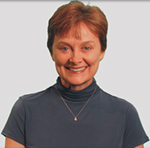DHED 314: Dental Hygiene Principles of Practice II
Jackie Singleton, R.D.H., M. Ed.

As a result of participating in the Spring 2009 Faculty Learning Community on Critical Thinking (FLC-CT), Dr. Singleton made changes to her course to help her students think more critically. By specifically incorporating the Paul-Elder framework for critical thinking and introducing processes that encourage students to ask questions that increase 1) the breadth of their understanding of a concept, and 2) their understanding of the role of "self-confidence" in their clinical performance for the week.
The Faculty Learning Community (FLC) opened my eyes to a new approach of teaching that engages the student in the learning process and helps them to think critically. As a result, students get more involved in the classroom activities and start asking higher level questions during class.
Use of the Paul-Elder framework for critical thinking
Dr. Singleton introduced the Paul-Elder approach to critical thinking to her students as a way to analyze various parts of thinking. Specifically, she created assignments that asked students to apply the Intellectual Standard of clarity when identifying and stating the following parts of the task:
- The main problem,
- The question at issue,
- Their assumptions,
- Their point of view,
- Relevant concepts,
- Information to support their claims, and
- The implications and consequences that follow their reasoning.
Encouraging students to ask questions
Dr. Singleton incorporated strategies that promote an understanding of the usefulness of the Paul-Elder framework for critical thinking into the design of her course. On such method, known as the SEE-I, is designed to deepen the learner's understanding of a concept. Through the process of stating a concept, elaborating on the definition given, providing and example of the concept, and finally illustrating the concept with an appropriate comparison, the SEE-I method helps to clarify sometimes difficult concepts. Dr. Singleton designed a SEE-I activity to help her students understand the concept of Clinical Attachment Levels (CAL) [PDF]. Dr. Susan Grammer, a colleague of Dr. Singleton, noticed the impact of the SEE-I activity on the learning and comprehension of the students:
I teach in a pre-clinical dental hygiene course with Jackie Singleton who was in the FLC program. I sat in on a lecture she was presenting that our students traditionally have trouble understanding. It is a lecture on clinical attachment levels of tissue and involves mathematical computations. In the past, the dental faculty have always struggled with this lecture even in the graduate course for dental students.
Jackie decided to group the students for this lecture and do one of the FLC techniques called a See- I (I think that is what it is called). By the end of the lecture, the students really seemed to understand this concept and they could explain it in class. I basically thought this was interesting, but I was skeptical that they could actually understand this and apply it to their patients.
A few days later when I was grading students in the clinic, I was amazed that the students not only remembered what the clinical attachment level was but they were able to apply it to their patient. After that I decided to apply to the Fall FLC program.
Dr. Singleton also developed a confidence assessment that asked her students to rate their level of "self-confidence" for their clinical performance for each week [PDF]. The process of regular reflection helps to guide students towards the Intellectual Traits of perseverance, autonomy, and humility.
